In August 2025, AntibodySystem products continued to provide strong support for global scientific research, with a total impact factor of over 180+. Products from AntibodySystem were cited in academic journals such as Nature Medicine, Nature Microbiology, Advanced Functional Materials, Cancer Research, and Nature Communications. The research covers a wide range of fields, including the world’s first xenotransplantation, bacterial antiviral mechanisms, respiratory syncytial virus vaccine development, and cancer metabolism studies. Moving forward, AntibodySystem will continue to collaborate with global research teams, supporting life science exploration with innovative reagents and technologies to advance scientific frontiers. Join Dr. Connie today to explore some of the August citation highlights featuring AntibodySystem products.
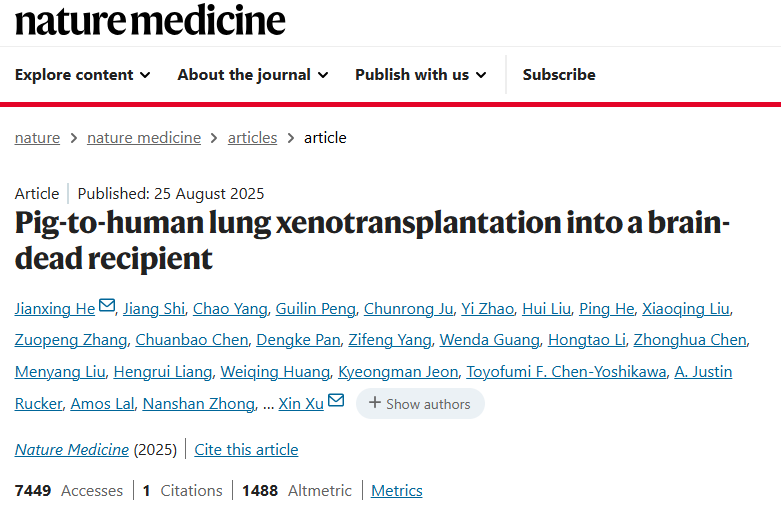
|
Title |
Pig-to-human lung xenotransplantation into a brain-dead recipient |
|
Journal Information |
Nat Med. 2025 Aug 25. |
|
Cited products |
|
|
Catalog |
Product Name |
|
RHJ92831 |
Anti-Human IgG Antibody (R1C56) |
|
RHJ93203 |
Anti-Human IgM Antibody (SAA0809) |
|
PHC45301 |
Anti-Human C4d Polyclonal Antibody |
This study reports the first case of lung xenotransplantation from a six-gene-edited pig to a 39-year-old brain-dead male recipient. The pig lung xenograft maintained viability and function throughout the 216-hour observation period, with no signs of hyperacute rejection or infection. Severe edema resembling primary graft dysfunction was observed at 24 hours post-transplantation, potentially related to ischemia-reperfusion injury. Antibody-mediated rejection was observed on postoperative days 3 and 6, causing some degree of injury, with partial recovery by day 9. This study preliminarily demonstrates the feasibility of pig-to-human lung xenotransplantation, but significant challenges such as rejection and infection remain. Further preclinical studies are necessary before this procedure can be advanced to clinical applications.

In this study, Anti-Human IgG Antibody (R1C56) (CAT#RHJ92831),Anti-Human IgM Antibody (SAA0809) (CAT#RHJ93203),Anti-Human C4d Polyclonal Antibody(CAT#PHC45301) from the AntibodySystem were utilized in IHC experiments to detect the deposition of IgG, IgM, and C4d in xenotransplanted lungs, successfully elucidating the key mechanisms of antibody-mediated rejection.
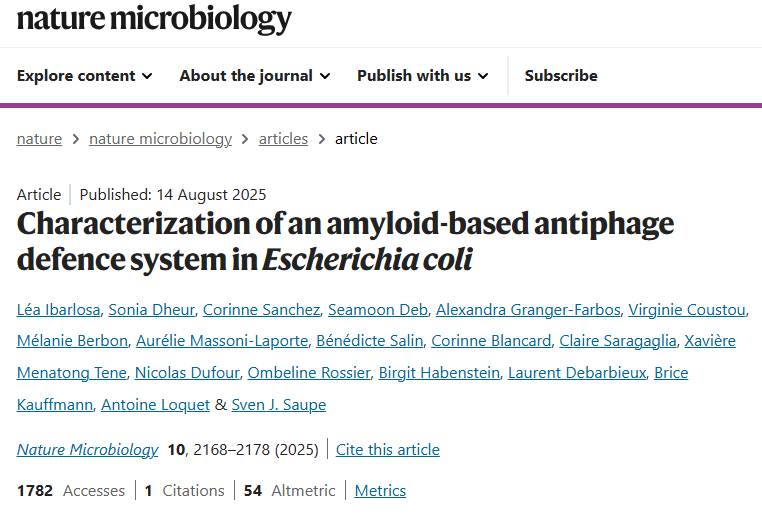
|
Title |
Characterization of an amyloid-based antiphage defence system in Escherichia coli |
|
Journal Information |
Nat Microbiol. 2025 Aug 14. |
|
Cited products |
|
|
Catalog |
Product Name |
|
RGK26301 |
Anti-Softag1 Tag (SLAELLNAGLGGS) Antibody (NT73) |
This study reports the discovery of an amyloid-mediated abortive infection antiphage defense system in Escherichia coli. The system consists of two proteins, Bab and Agp, which share a common amyloid motif and are encoded by adjacent genes. Following phage infection, Agp activates Bab through amyloid signaling, leading to membrane alterations and cell death, thereby preventing phage propagation. The structure of the cell death execution domain of Bab is distantly related to pore-forming domains found in fungi, animals, and plants. The study demonstrates that Bab is functionally interchangeable with HET-S, an amyloid-controlled cell death execution protein from the fungus Podospora anserina. These findings reveal that amyloid-mediated immune signaling is conserved across kingdoms.

This study cited the Anti-Softag1 Tag (SLAELLNAGLGGS) Antibody (NT73) (Cat#RGK26301) from AntibodySystem as a loading control in Western blot experiments to detect the expression level of the β′ subunit of Escherichia coli RNA polymerase, thereby verifying the uniformity of protein sample loading.

|
Title |
Characterization of an amyloid-based antiphage defence system in Escherichia coli |
|
Journal Information |
Nat Microbiol. 2025 Aug 14. |
|
Cited products |
|
|
Catalog |
Product Name |
|
RGK26301 |
Anti-Softag1 Tag (SLAELLNAGLGGS) Antibody (NT73) |
This study reports the discovery of an amyloid-mediated abortive infection antiphage defense system in Escherichia coli. The system consists of two proteins, Bab and Agp, which share a common amyloid motif and are encoded by adjacent genes. Following phage infection, Agp activates Bab through amyloid signaling, leading to membrane alterations and cell death, thereby preventing phage propagation. The structure of the cell death execution domain of Bab is distantly related to pore-forming domains found in fungi, animals, and plants. The study demonstrates that Bab is functionally interchangeable with HET-S, an amyloid-controlled cell death execution protein from the fungus Podospora anserina. These findings reveal that amyloid-mediated immune signaling is conserved across kingdoms.

This study cited the Anti-Softag1 Tag (SLAELLNAGLGGS) Antibody (NT73) (Cat#RGK26301) from AntibodySystem as a loading control in Western blot experiments to detect the expression level of the β′ subunit of Escherichia coli RNA polymerase, thereby verifying the uniformity of protein sample loading.
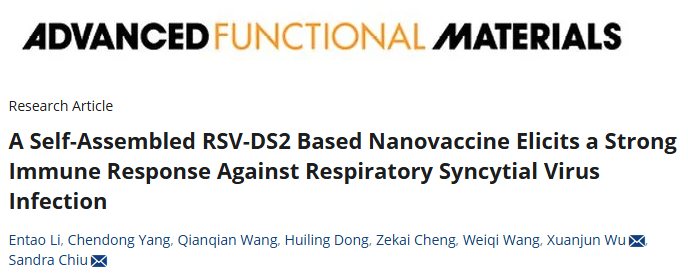
|
Title |
A Self-Assembled RSV-DS2 Based Nanovaccine Elicits a Strong Immune Response Against Respiratory Syncytial Virus Infection |
|
Journal Information |
Advanced Functional Materials, 28 August 2025 |
|
Cited products |
|
|
Catalog |
Product Name |
|
RVV02801 |
Anti-HRSV F/Fusion glycoprotein F0 Antibody (Am14) |
|
RVV02814 |
Anti-HRSV-A F/Fusion glycoprotein F0 Antibody (MPE8) |
|
RVV02816 |
Anti-HRSV-A F/Fusion glycoprotein F0 Antibody (101F) |
|
RVV02813 |
Anti-HRSV-A F/Fusion glycoprotein F0 Antibody (VHH4) |
This study developed a self-assembled nanovaccine by conjugating RSV prefusion F protein (DS2) with PC7A polymer and co-adsorbing it with CpG. In mice, this DS2–PC7A/CpG nanovaccine induced higher neutralizing antibodies against RSV A and B subtypes and broader T-cell responses than single-adjuvant formulations. It significantly reduced lung viral load and inflammation after RSV challenge, demonstrating strong potential as a synergistic dual-adjuvanted vaccine.

The study cited AntibodySystem's Anti-HRSV F/Fusion glycoprotein F0 Antibody (Am14) (Cat#RVV02801), Anti-HRSV-A F/Fusion glycoprotein F0 Antibody (MPE8) (Cat#RVV02814), Anti-HRSV-A F/Fusion glycoprotein F0 (RVV02816), and Anti-HRSV-A F/Fusion glycoprotein F0 Antibody (VHH4) (Cat#RVV02813) for ELISA experiments to detect the conformational integrity of the RSV F protein antigen in the nanovaccine, thereby verifying whether the key antigenic epitopes of the antigen remained correct after conjugation to the nanocarrier.
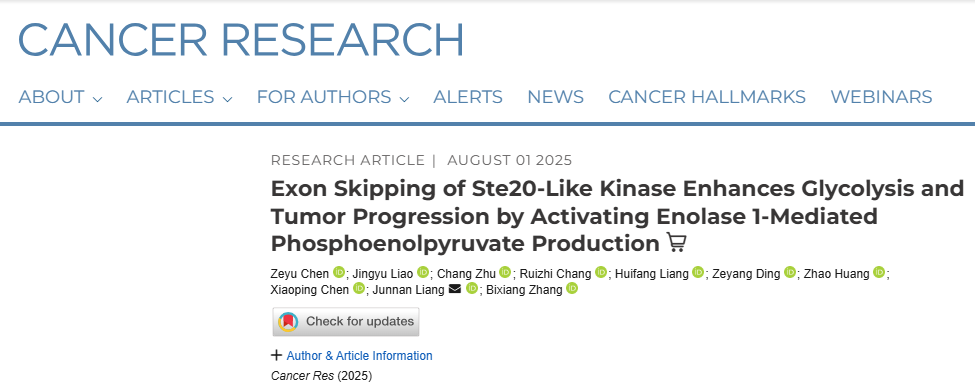
|
Title |
Exon Skipping of Ste20-Like Kinase Enhances Glycolysis and Tumor Progression by Activating Enolase 1-Mediated Phosphoenolpyruvate Production |
|
Journal Information |
Cancer Res. 2025 Aug 1. |
|
Cited products |
|
|
Catalog |
Product Name |
|
YHC31701 |
Recombinant Human PFKM Protein, N-His |
|
YHC09001 |
Recombinant Human GAPDH Protein, C-His |
|
YHF34301 |
Recombinant Human TPI1 Protein, N-His |
RNA splicing dysregulation in cancer alters cellular metabolism. This study identifies an exon-skipping event in Ste20-like kinase (SLK), generating a variant (SLKv) that promotes glycolysis. SLKv binds and phosphorylates enolase 1 (ENO1), boosting its production of phosphoenolpyruvate (PEP). PEP then allosterically activates key glycolytic enzymes—hexokinase 2, phosphofructokinase, and phosphoglycerate mutase 1—to accelerate glycolysis. TGFβ induces this splicing event via upregulation of the splicing factor KHDRBS1. Targeting SLKv inhibits glycolysis and tumor growth, highlighting its potential as a metabolic therapeutic target in cancer.

The study cited AntibodySystem 's Recombinant Human PFKM Protein, N-His (Cat# YHC31701), Recombinant Human GAPDH Protein, C-His (Cat# YHC09001), and Recombinant Human TPI1 Protein, N-His (Cat# YHF34301) for in vitro enzymatic activity assays and related experiments. These investigations aimed to elucidate the role of these glycolytic enzymes in tumor metabolism, thereby providing a theoretical foundation for the development of novel cancer therapeutic strategies.
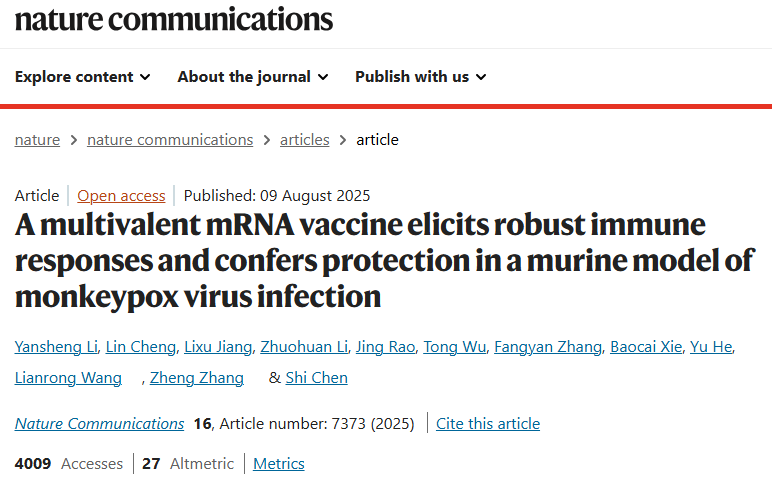
|
Title |
A multivalent mRNA vaccine elicits robust immune responses and confers protection in a murine model of monkeypox virus infection |
|
Journal Information |
Nat Commun. 2025 Aug 9;16(1):7373. |
|
Cited products |
|
|
Catalog |
Product Name |
|
PVV13101 |
Anti-Monkeypox virus/MPXV A35R Polyclonal Antibody |
In response to the global re-emergence of monkeypox virus (MPXV), we developed two multivalent mRNA vaccines: AAL (encoding three MPXV antigens) and AALI (AAL combined with immune-enhancing IFN-α). Delivered via mannose-modified lipid nanoparticles targeting dendritic cells, both vaccines elicited potent neutralizing antibodies, memory B- and T-cell responses, and promoted dendritic cell maturation. In mouse challenge models, they provided protection against clade IIb MPXV and vaccinia virus, significantly reducing viral loads and lung pathology. Immune profiling revealed expanded B- and T-cell receptor diversity post-vaccination. This study demonstrates that multivalent mRNA vaccines are an effective strategy against mpox and related orthopoxvirus infections.

The study cited AntibodySystem 's Anti-Monkeypox virus/MPXV A35R Polyclonal Antibody (Cat# PVV13101) for Western blot analysis to verify the in vitro expression of the MPXV A35R antigen encoded by the mRNA vaccine candidates (AAL and AALI), thereby confirming the accurate translation and antigen integrity of the vaccine-encoded immunogen.
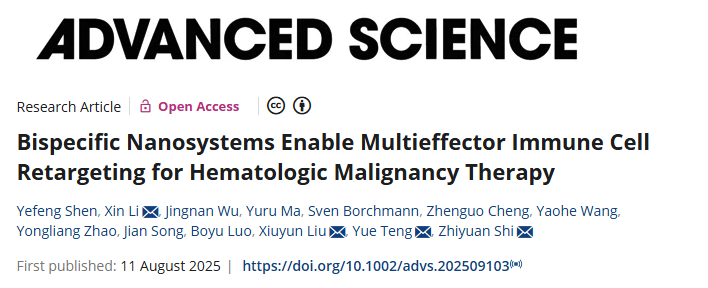
|
Title |
Bispecific Nanosystems Enable Multieffector Immune Cell Retargeting for Hematologic Malignancy Therapy |
|
Journal Information |
Adv Sci (Weinh). 2025 Aug 11:e09103. |
|
Cited products |
|
|
Catalog |
Product Name |
|
DHD10803 |
Research Grade Tafasitamab |
|
DHC27701 |
Research Grade Muromonab |
|
FHC35010 |
Anti-Human CD16 Antibody (3G8) |
B-cell lymphomas remain challenging due to limitations of current immunotherapies. We developed a versatile bispecific silica nanosystem (biHSNPs) conjugated with antibodies targeting both immune effector cells (T/NK cells) and B-cell lymphoma antigens. This design facilitates the formation of artificial immunological synapses, leading to immune cell activation, release of cytotoxic proteins, and suppression of tumor proliferation. In a xenograft model, biHSNPs effectively inhibited tumor growth and enhanced T-cell activation while overcoming immune evasion. This scalable strategy offers a promising precision therapy for hematologic malignancies, surpassing the drawbacks of existing bispecific antibodies and CAR-T therapies.

The study cited AntibodySystem's Research Grade Tafasitamab (Cat# DHD10803), Research Grade Muromonab (Cat# DHC27701), and Anti-Human CD16 Antibody (3G8) (Cat# FHC35010). These antibodies were used to functionalize hollow silica nanoparticles (HSNPs) for the construction of bispecific nanosystems (biHSNPs). Flow cytometry and confocal microscopy were then employed to verify their specific binding to both immune effector cells and B-cell lymphoma cells, thereby confirming that biHSNPs can efficiently mediate immune-tumor cell interactions and activate specific cytotoxic responses.
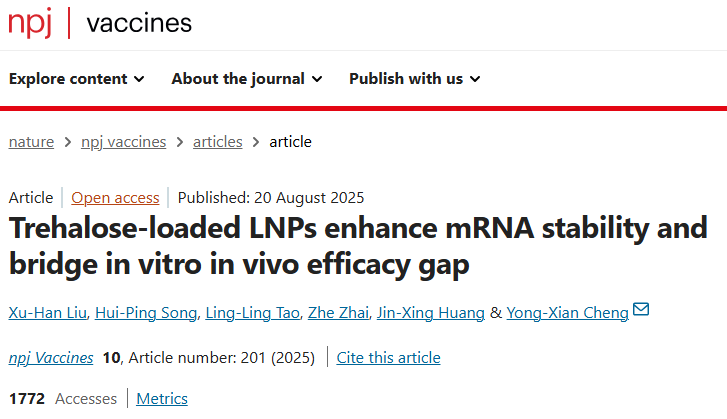
|
Title |
Trehalose-loaded LNPs enhance mRNA stability and bridge in vitro in vivo efficacy gap |
|
Journal Information |
NPJ Vaccines. 2025 Aug 20;10(1):201. |
|
Cited products |
|
|
Catalog |
Product Name |
|
PTB96441 |
Goat Anti-Rabbit IgG H&L Polyclonal Antibody-FITC |
|
PHH25001 |
Anti-NFE2L2 Polyclonal Antibody |
Lyophilization improves mRNA vaccine stability, but conventional external trehalose use only preserves lipid nanoparticle (LNP) colloidal stability, neglecting mRNA chemical degradation. We developed a dual-function trehalose strategy that integrates external and internal roles: externally, it forms a vitrified matrix safeguarding LNP integrity; internally, it stabilizes mRNA via hydrogen bonding, reducing chemical degradation. Co-delivered trehalose mitigates oxidative stress in vivo by lowering ROS and MDA while elevating GSH and SOD, linked to downregulated Nrf2. This simple, scalable approach enhances mRNA-LNP stability without complex steps or exogenous components.

The study cited AntibodySystem's Anti-NFE2L2 Polyclonal Antibody (Cat# PHH25001) and Goat Anti-Rabbit IgG H&L Polyclonal Antibody-FITC (Cat# PTB96441). These antibodies were used in Western Blotting (WB) and Immunofluorescence (IF) experiments to analyze the expression and localization of the nuclear factor Nrf2 in HEK293T cells. This was aimed at verifying the mechanism by which trehalose enhances the transfection efficiency of mRNA-lipid nanoparticles (mRNA-LNPs) by regulating the oxidative stress pathway, thereby providing molecular-level evidence for the intracellular protective effect of trehalose-loaded LNP (TL-LNP) formulations.

|
Title |
Camel-Milk-Derived Extracellular Vesicles Mitigate High-Fat-Diet-Induced Obesity by Enhancing Thermogenesis and Modulating Lipid Metabolism in Mice |
|
Journal Information |
J Agric Food Chem. 2025 Aug 14. |
|
Cited products |
|
|
Catalog |
Product Name |
|
MHB94402 |
Anti-Human TNFa/TNF-alpha Monoclonal Antibody (1A062) |
Obesity is a major health issue associated with metabolic disorders. This study explores the effect of camel milk-derived extracellular vesicles (mEVs) on high-fat-diet-induced obesity in mice. Oral administration of mEVs reduced fat accumulation, decreased serum lipids, and enhanced cold-induced thermogenesis, as shown by elevated oxygen consumption and heat production. RNA-seq of brown fat indicated upregulation of thermogenic and oxidative phosphorylation genes. mEVs also modulated gut microbiota, increasing beneficial bacteria and partially restoring short-chain fatty acids. These findings suggest mEVs as a potential therapeutic strategy for improving metabolic health through enhanced BAT thermogenesis.

The study cited AntibodySystem's Anti-Human TNFa/TNF-alpha Monoclonal Antibody (1A062) (Cat# MHB94402). This antibody was used in Western Blotting (WB) experiments to detect the expression level of TNF-α protein in brown adipose tissue (BAT) of mice from different experimental groups. The purpose was to analyze the regulatory effect of camel-milk-derived extracellular vesicles (mEVs) on the expression of inflammation-related proteins in the brown adipose tissue of obese mice induced by a high-fat diet, thereby providing experimental evidence for clarifying the mechanism by which mEVs improve metabolic disorders by inhibiting inflammatory responses.
|
Other Partical list of citations |
||
|
August 2025 |
||
|
Catalog |
Product Name |
PMID |
|
RGK08101 |
Anti-Hypusine antibody (Hpu24) |
40819533 |
|
PHF91801 |
Anti-DHODH Polyclonal Antibody |
40885318 |
|
YHF70701 |
Recombinant Human LCN2 Protein, N-His |
40790086 |
|
DHF88301 |
Research Grade Astegolimab |
40801996 |
|
FHC33710 |
Anti-Human CD14 Antibody (28C5) |
40835202 |
|
RHD41101 |
Anti-CD11c/ITGAX Antibody (R3F77) |
|
|
FHM00920 |
Anti-Human HLA-DRB1 Antibody (1D10) |
|
|
FHC42110 |
Anti-Human CSF1/M-CSF Antibody (SAA0417) |
|
|
DHD00601 |
Research Grade Tisotumab |
40896442 |
|
DVV02802 |
Research Grade Nirsevimab |
40784574 |
Given space constraints, the specific details of other citations are not expounded upon in full herein. Interested readers are advised to refer to the complete versions for comprehensive information.
The above represents a selection of references from August 2025 that cited AntibodySystem products. AntibodySystem provides a full range of research reagents, including recombinant proteins, flow cytometry antibodies, anti-IgE antibodies, phospho-specific antibodies, and ELISA kits. These products are designed to support studies in drug target identification, immune response analysis, allergy mechanism research, and cancer therapy development.
